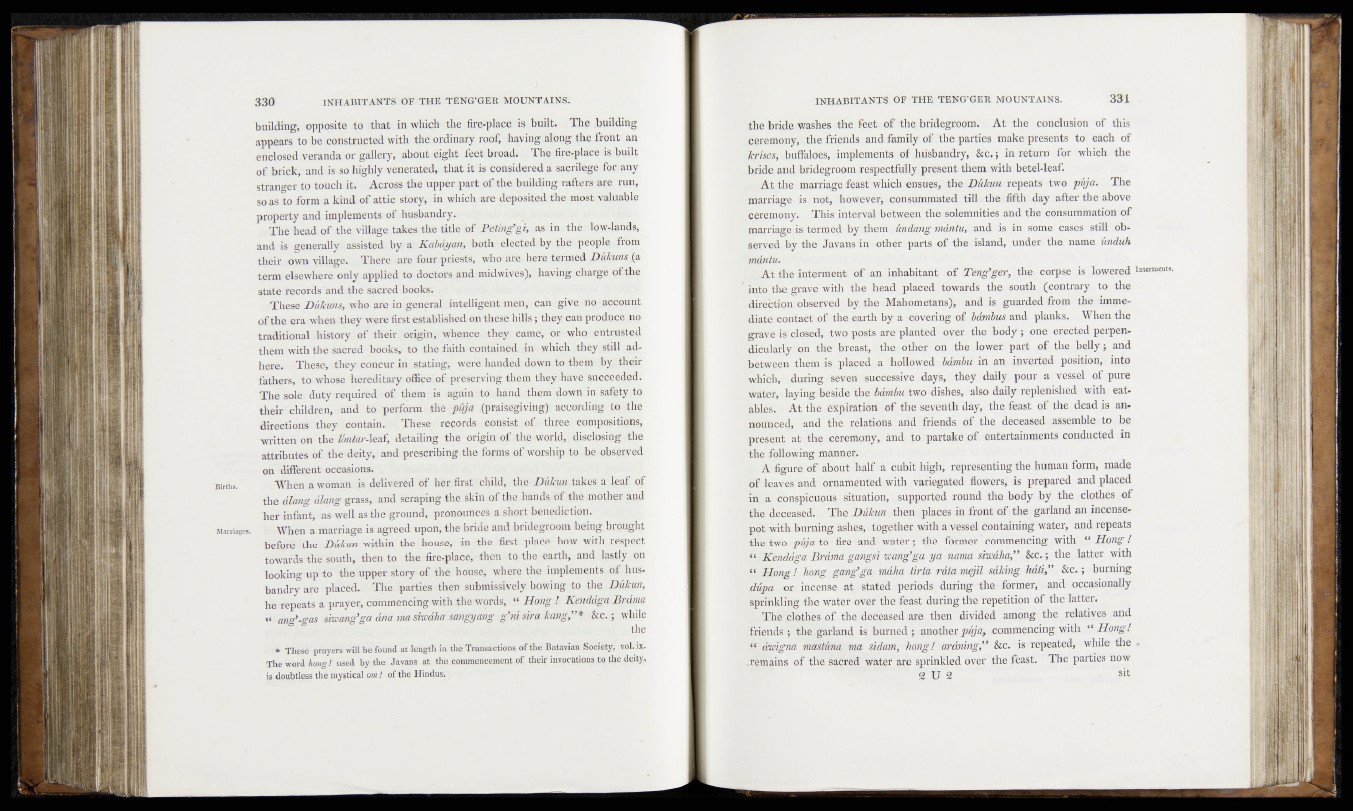
330 INHABITANTS OF THE TENG’GER MOUNTAINS.
Births.
Marriages.
building, opposite to that in which the fire-place is built. The .building
appears to be constructed with the ordinary roof, haying dong the front an
enclosed veranda or gallery, about eight fret broad, Thé'jSre,,place is built
of brick, - and is so highly venerated,, that it is considered a sacrilege forrany
stranger to touch it. Across the upper part of the building rafters are run,
so as to form a kind of attic story, in which are deposited the most.valuable
property and implements of .husbandry,»-.'!.-
The head of the village .takes the title of Poting’gi, as in' the low-lands,
and is generally .assisted-by a .Kabdywh both elected by the people „fern
their own village. There are four-priests, who1 are her<e_fenrted D-fcJcyns (a
term' elsewhere, only applied to doctors and midwiyéS'Ssi haying charge pf-fee
State records and the, sacred-,books*, -
These Dükims, who are in general-‘ intelligent men, Can give)nó:as0#Wt
of the era when they were first established, on these hiUs 5 they! eanprpjfepj^&o-
traditional history of their origin,,, whence feey. .came; on'iwhfr<tCh^sJed
them with the sacred'hooka,: to the faith contained fin, which, jfeey. still -adr
here. These, feey concur in stating, were handed down to.feepjribysffeeir
fathers, to whose hereditary office. .of-presepying them they have'succeeded.
Tby doty required of them is again to hand rthem down in safety to
their children, and .to perform the p^ja (praisegjvmg)', according toffee
directions th ey | Contain. ' These ' records .eonsjsfrofe-thïe.C composites.»
written on the-^nfetr-leaf, detailing the origin-i©f the world, rfesclpsfogf jfee
attributes of the-deity,- , and prescribing the forms o&whsship fe/fec efos§fiifed
on different occasions^ .
When a woman is delivered of her first/ ehdd,. the fiukurt takes« AjlpaJJ of
the along dkmg grass, and scraping fed.skin o f fee handydi#^mofeer and
her infant, as well as the ground, .pronounces ajshort benedict-fop.
- When a 1 marriage as agreed upon, the bride and bridegroom b<^gferp,ught
before the D&kun within the house, in the first place bow with respect
towards the south, then to. .the fire-place, Ahenhtó the-earth, and lastjy- bn
looking upiif© the upper story of the . house, where fee impfrme,©jts5;0&ifeS-
bandry are placed.;-, The parries then submissively, bowing to fee'jH$}mn,
he repeats a prayer, commencing with the words, “ Hong KehddgtyBr-dpia
« ang’-gas smmg’ga dna ma siwdha sangyang .g’ni sir a kang,”* &c. i Vtfhile
f-^fee
.# prayers^-snjl fce found a t length in the Transactions of'the Batayian Society, 'rol. ix.
The word hong! used by^tfae Javans at the commencement of their invocations i,o foe deity,
I js doubtless thé mystical. <ml of the Hindus. -
INHABITANTS OF THE TENG’GER MOUNTAINS. 331
the bride Washes the feet of the bridegroom. At the conclusion of this
ceremony,' the friends and family of ’the parties make presents to each of
'kriSfiSi (buffaloes, implements of husbandry, &c.; in return for which the
bride, and bridegroom respectfully .present them with betel-leaf.
At the marriage feast which ensues, fee Diikun repeats two puja. The
marriage dsfnot, however, consummated till, the fifth day after the above
'cpemony. This,interval between the.solemnities and the consummation of
marriage is. fer^edfeyithem' .éndang mdntu, -and is fer some eases still observed
by th 6^ da vans in other parts of fee island, under fee name iinduh
mdntu.
■_ At the interment of. an inhabitant of Teng'ger, the corpse is lowered interments,
into.the grave with *fee head placed towards the south (contrary to fe©
■direction,observed by fee'Mahometans)’, and is guarded from-the immediate
Contact pf- the earth, by a -cavering of bdmhus and planks. When fee
grave is' closed, two posts are planted over the body; one erected perpendicularly‘
on the breast, r th e : ofeer on the lower part of ; fee belly 5, and
.between thgm,is placed a hollowed bdmbU ill an inverted position, into
which, during seven -successive..days, they daily pour apvessel of pure
water,Ayingjfostde the.bdmbu two-dishes, also daily replenished with eatables,
• At the expiration!^..' fee seventh day,,fee feast o f the dead is an-
soub’cetj, and the relations and friends of the deceased assemble to be
^present af<jfee >cetomonyi and to partake of entertainments conducted in
the following manner.
A-figure oft about half a cCibit high, representing the human form, made
óf leaves 1 and' ornamented with variegated flowers,' is prepared and placed
in a conspicuous situation, supported round the body by fee clothes of
fee>j deceased. ' The Dukun then places in front of fee garland an incense-
pot’with burning ashes, together with a-vessel containing water, and repeats
thetwio ptya to fire and water; fee former'commencing wife “ Hong i
}‘ ii&nddga Brdma gangsi 'wcmg’ga ya noma sivodka” &C.,; fee,-Tatter wife
“ Hong l hong gang'.gqi maha tirta rdfa mejil Mking. hdti,” &e,; burning
ddpa , or .incense- at stated periods during fee former, and occasionally
sprinkling fe e water over the feast during feh repetition of the'latter: ‘
Théiglofejss qjE^fee -deceased are feen divided among fee relatives apd
fiends ; the garland is burnèd ; another puffy commencing wife “ Hong!
H'dwigna mastüna ma sidam, hong 1'ardningP &e. is repeated; while fee .
.remains of fee/sacred’ wafer are sprinkled over f e e ’feast. The parties now
1 g i j 2 - sit